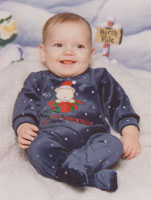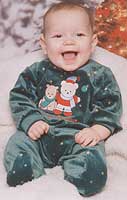To witness a miracle is one of life's rarest and most extraordinary blessings. Stevie Sipes has witnessed two.
 Stevie's journey began in 2003, when she noticed a painful bump on her head. Further testing revealed bone lesions throughout her body - on her back, leg, hip, knee, clavicle and other bones. Stevie was diagnosed with Langerhans cell histiocytosis (LCH), a disease that arises from a defective immune system that cannot regulate itself. As a result, healthy tissue and organs are attacked by damaging histiocytes. In Stevie’s case, the disease was particularly aggressive, attacking her lungs and bones, causing serious damage.
Stevie's journey began in 2003, when she noticed a painful bump on her head. Further testing revealed bone lesions throughout her body - on her back, leg, hip, knee, clavicle and other bones. Stevie was diagnosed with Langerhans cell histiocytosis (LCH), a disease that arises from a defective immune system that cannot regulate itself. As a result, healthy tissue and organs are attacked by damaging histiocytes. In Stevie’s case, the disease was particularly aggressive, attacking her lungs and bones, causing serious damage.
"Stevie had an aggressive form of the disease," explains Dr. Shalini Shenoy, associate director of the bone marrow transplant program at St. Louis Children's Hospital. "It progressed in her lung affecting lung function significantly despite treatment."
Several rounds of chemotherapy of increasing intensity did nothing to improve her lung function and reduce the lesions.
"My doctors told me that I would probably be sterile and wouldn't have kids after all the therapy," says Stevie. "They believed that the high doses of chemotherapy would probably ruin my ovaries."
Beyond chemotherapy, Stevie's last option was a bone marrow transplant. It would replace her defective immune system with a healthy one. But it would mean more chemotherapy as conditioning for the transplant. "She had tried a lot of other less intense options that are often helpful for this disease, but the disease progressed through all of them," explains Dr. Shenoy. "There was no other way to control it other than to change over the immune system."
Infertility is one potential late-effect, or consequence of chemotherapy and transplant. "We always discuss this possibility and the other late effects that might develop with treatment" says Dr. Shenoy. A reduced intensity transplant was planned using antibodies and lowered doses of chemotherapy, to try to decrease the incidence of late effects.
Fortunately, Stevie found a perfect bone marrow match in her younger sister, Amber. "There was no question in her mind," says Stevie, "Amber said she would donate."
Stevie believes having the support of her sister, as well as the rest of her family and her fiancé, Josh, helped her through this very difficult time. "It was crazy, scary and emotional. I don't know what I'd do without my family."
After a successful bone marrow transplant, her immune system began to regulate itself. The lesions got better. Her lung function stabilized and improved. Things were getting back to normal. She was able to gradually stop all her medicines.
Then, about 9 months later came another surprise.
 Stevie was pregnant.
Stevie was pregnant.
"The doctor who'd warned me it'd be difficult to have kids was so surprised! He was shocked," says Stevie. "I don't know if there are even words for it."
Dr. Shenoy credits the reduced-intensity chemotherapy regimen given at St. Louis Children's Hospital for Stevie's ability to sustain her pregnancy. The goal of this approach is to have a successful transplant while preventing some of the late effects known to be associated with treatment.
"This is cautiously encouraging. We hope to be able to preserve fertility in at least a part of the patients undergoing such transplants."
Less than 18 months after her bone marrow transplant, Stevie gave birth to a set of healthy twin boys. Cori and Dalton were born May 12, 2004.
 "What's amazing is that despite all the rough periods of treatment for her disease in the recent past, she was able to manage a pregnancy and have two normal babies," says Dr. Shenoy.
"What's amazing is that despite all the rough periods of treatment for her disease in the recent past, she was able to manage a pregnancy and have two normal babies," says Dr. Shenoy.
Stevie's story is not a common one. Many patients have ovarian failure or premature menopause after transplant because the chemotherapy decreases the ability to make estrogen. Hence,Stevie’s story has some encouraging implications for girls facing this kind of treatment.
"Though this is a reduced intensity approach, there is still an initial rocky post transplant period because of the enormous changes and adjustments made by the body to adjust to cells from another donor. This is a period where close follow up is required to help the body adjust sufficiently. But if everything goes OK, a patient can look forward to life eventually returning to normal," says Dr. Shenoy.
Stevie does admit she has some late effects of her previously prolonged treatment, including periodic pain in her bones.
There are even some late effects Stevie is grateful to have. "My relationship with my mom and sister is better after going through all this. I feel like my sister saved my life."
And Stevie will always have two healthy, happy reminders of her miracles, her recovery, and the late effects that didn't happen.










